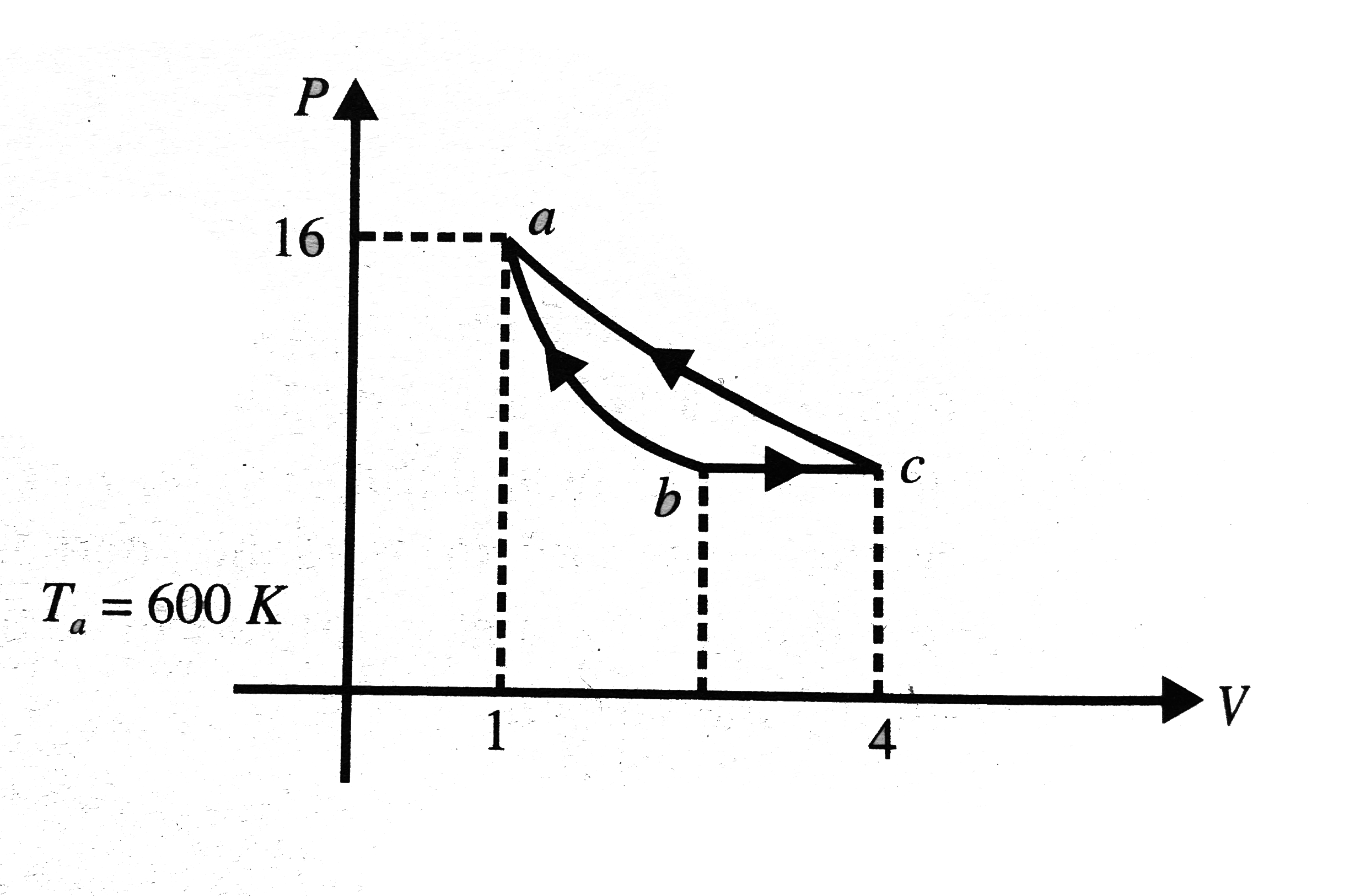Figure. Shows three processes for an ideal gas. The temperature at 'a' is 600 K, pressure of atm, and volume 1 L. The volume at 'b' is 4 L. Out of two processes, ab and ac, one is adiabatic and other is isothermal. The ratio of specific heats of the gas is 1.5.
a. Which of the processes ab and ac is adiabatic ? Why
b. Compute the pressure of the gas at b and c.
c. Compute the temperature at b and c.
d. Complete the volume at c.

a. The process ab is adiabatic because it is steeper than ac.
b. Pa=16atm,Vb=4L,Va=1L
⇒Ta=600K
Process 'ab' (adiabatic)
⇒PaVγa=PbVγb
Pb=Pa(VaVb)γ=16×(14)1.5
⇒Pb=2atm
As bc is isobaric,
Pb=Pc=2atm
c. Tc=Ta=600K because ac is isothermal
Process 'ab' is adiabatic hence
Tb can be calculated using TaVγ−1a=TbTγ−1b
⇒(PaVaTa)=(PbVbTb)
Hence, Tb=Ta(VaVb)γ−1=600(14)0.5=300K
d. Process 'ac' (isothermal)
⇒PaVa=PcVc
Vc=PaVaPc=(16×1)2=8L
Topper's Solved these Questions
- KINETIC THEORY OF GASES AND FIRST LAW OF THERMODYNAMICSBook:CENGAGE PHYSICSChapter:KINETIC THEORY OF GASES AND FIRST LAW OF THERMODYNAMICSExercise:Exercise 2.1
Explore 20 Videos
- KINETIC THEORY OF GASES AND FIRST LAW OF THERMODYNAMICSBook:CENGAGE PHYSICSChapter:KINETIC THEORY OF GASES AND FIRST LAW OF THERMODYNAMICSExercise:Exercise 2.2
Explore 28 Videos
- KINETIC THEORY OF GASES AND FIRST LAW OF THERMODYNAMICSBook:CENGAGE PHYSICSChapter:KINETIC THEORY OF GASES AND FIRST LAW OF THERMODYNAMICSExercise:Interger
Explore 11 Videos
- KINETIC THEORY OF GASESBook:CENGAGE PHYSICSChapter:KINETIC THEORY OF GASESExercise:Compression
Explore 2 Videos
- LINEAR AND ANGULAR SIMPLE HARMONIC MOTIONBook:CENGAGE PHYSICSChapter:LINEAR AND ANGULAR SIMPLE HARMONIC MOTIONExercise:Multiple Correct Answer Type
Explore 9 Videos
Similar Questions
Knowledge Check
Calculate the moles of an ideal gas at pressure 2atm and volume 1L at a temperature of 97.5K
A1B2C3D4A gas at 10∘C temperature and 1.013xx105 Pa pressure is compressed adiabatically to half of its volume. If the ratio of specific heats of the gas is 1.4, what is its final temperature?
A103∘CB123∘CC93∘CD146∘CAn ideal monatomic gas expands to twice its volume. If the process is isothermal, the magnitude of work done by the gas is W1. If the process is adiabatic, the magnitude of work done by the gas is Wa . Which of the following is true ?
AWi=Wa>0BWi>Wa=0CWi>Wa>0DWi>Wa>0
An ideal gas with pressure P, volume V and temperature T is expanded isothermically to a volume 2V and a final pressure Pi, If the same gas is expanded adiabatically to a volume 2V, the final pressure Pa. The ratio of the specific heats of the gas is 1.67. The ratio PaP1 is .......
View SolutionCan two states of an ideal gas be connected by an isothermal process as well as an adiabatic process?
View SolutionAn ideal diatomic gas undergoes a process in which the pressure is proportional to the volume. Calculate the molar specific heat capacity of the gas for the process.
View SolutionDoes the internal energy of an ideal gas change in an isothermal process? In an adiabatic process?
View SolutionOne mole of an ideal gas at an initial temperature true of TK does 6R joule of work adiabatically. If the ratio of specific heats of this gas at constant pressure and at constant volume is 5/3, the final temperature of the gas will be
View Solution

